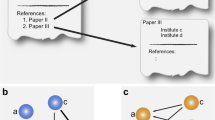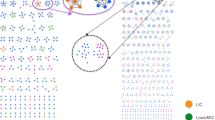Abstract
This paper explores the role of sectors in scientific research and development networks by drawing on bibliometric analyses and innovation systems and triple helix literatures. I conducted a bibliometric study of Vancouver Canada’s worldwide infection and immunity network and examined network structure through sociograms, social network metrics, as well as relational contingency table and ANOVA network analyses. Universities are the key network sector followed by hospitals and government organisations. The private sector plays a weak role. Most sectors show a preference for collaborating within, as opposed to across, sectors. This trend is most pronounced in hospitals and least pronounced among firms. Hospitals and universities collaborate well above statistical expectations. I discuss the implications of these findings for future science policy and studies of research and development networks.


Similar content being viewed by others
Notes
Canada’s health and education systems are almost exclusively publicly funded.
See http://www.statcan.gc.ca/pub/92f0138m/2003002/4225101-eng.pdf (Accessed September 28, 2010).
See McGinn et al. (2004) for guidelines on how to interpret the κ statistic.
See Borgatti and Everett (1997), p. 254 for a further explanation of the calculation and interpretation of two-mode degree statistics.
References
Ahuja, G. (2000). Collaboration networks, structural holes and innovation: A longitudinal study. Administrative Science Quarterly, 45(3), 425–455.
Atkinson-Grosjean, J., & Douglas, C. (2010). The third mission and the laboratory: How translational science engages and serves the community. In P. Inman & H. G. Schuetze (Eds.), The community engagement and service mission of universities (pp. 309–323). Leicester: Naice.
Borgatti, S. P. (2002). NetDraw: Graph visualization software. Harvard: Analytic Technologies.
Borgatti, S. P., & Everett, M. G. (1997). Network analysis of 2-mode data. Social Networks, 19(3), 243–269.
Borgatti, S. P., Everett, M. G., & Freeman, L. C. (2002). UCINET 6 for windows: Software for social network analysis. Harvard: Analytic Technologies.
Bourgeosi, F. T., Murthy, S., & Mandl, K. (2010). Outcome reporting among drug trials registered in ClinicalTrials.gov. Annals of Internal Medicine, 153(3), 158–166.
Burt, R. (1992). The social structure of competition. In N. Nohria & R. G. Eccles (Eds.), Networks and organization: Structure, form and action (pp. 57–91). Boston: Harvard Business School Press.
Cliff, A. D., & Ord, J. K. (1973). Spatial autocorrelation. London: Pion.
Conti, N., & Doreian, P. (2010). Social network engineering and race in a police academy: A longitudinal analysis. Social Networks, 32, 30–43.
Cooke, P. (1998). Introduction: Origins of the concept. In H. Braczyk, P. Cooke, & M. Heidenreich (Eds.), Regional innovation systems (pp. 2–27). Reading: UCL Press.
Cross, R., Borgatti, S. P., & Parker, A. (2001). Beyond answers: Dimensions of the advice network. Social Networks, 23, 215–235.
Djellal, F., & Gallouj, F. (2005). Mapping innovation dynamics in hospitals. Research Policy, 34(6), 817–835.
Dosi, G. (1982). Technological paradigms and technological trajectories: A suggested interpretation of the determinants and directions of technical change. Research Policy, 11(3), 147–162.
Edquist, C. (2005). Systems of innovation: Perspectives and challenges. In J. Fagerberg, D. C. Mowery, & R. R. Nelson (Eds.), The Oxford handbook of innovation (pp. 181–208). Oxford: Oxford University Press.
Edquist, C., & Johnson, B. (1997). Institutions and organizations in systems of innovation. In C. Edquist (Ed.), Systems of innovations: Technologies, institutions and organizations (pp. 41–63). London: Pinter Publishers.
Etzkowitz, H., & Leydesdorff, L. (1999). The future location of research and technology transfer. Journal of Technology Transfer, 24, 111–123.
Etzkowitz, H., & Leydesdorff, L. (2000). The dynamics of innovation: From national systems and ‘mode 2’ to a triple helix of university-industry-government relations. Research Policy, 29, 109–123.
Etzkowitz, H., Webster, A., Gebhardt, C., & Terra, B. R. C. (2000). The future of the university and the university of the future: Evolution of ivory tower to entrepreneurial paradigm. Research Policy, 29, 313–330.
Gelijns, A. C., Zivin, J. G., & Nelson, R. R. (2001). Uncertainty and technological change in medicine. Journal of Health Politics, Policy and Law, 25(5), 913–924.
Gilding, M. (2008). The tyranny of distance: Biotechnology networks and clusters in the antipodes. Research Policy, 37, 1132–1144.
Godin, B. (1996). Research and the practice of publication in industries. Research Policy, 25(4), 587–606.
Goes, J. B., & Park, S. H. (1997). Interorganizational links and innovation: The case of hospital services. The Academy of Management Journal, 40(3), 673–696.
Gregersen, B. (1992). The public sector as a pacer in national systems of innovation. In B. Lundvall (Ed.), National systems of innovation: Towards a theory of innovation and interactive learning (pp. 129–145). London: Pinter Publishers.
Hanneman, R. A., & Riddle, M. (2005). Introduction to social network methods. Riverside: University of California (published in digital form at http://faculty.ucr.edu/hanneman/).
Hansen, M. (1999). The search-transfer problem: The role of weak ties in sharing knowledge across organizational subunits. Administrative Science Quarterly, 44(1), 82–111.
Hicks, D., & Katz, J. S. (1996). Hospitals: The hidden research system. Science and Public Policy, 23(5), 297–304.
Holbrook, J. A., & Clayman, B. P. (2006). Research funding by city: An indicator of regional technological competitiveness? Research Evaluation, 15(3), 221–231.
Hopkins, M. (2006). The hidden research system: The evolution of cytogenetic testing in the National Health Service. Science as Culture, 15(3), 253–276.
Katz, J. S., & Martin, B. R. (1997). What is research collaboration? Research Policy, 26, 1–18.
Lander, B., & Atkinson-Grosjean, J. (2011). Translational science and the hidden research system in universities and academic hospitals: A case study. Social Science and Medicine, 72, 537–544.
Lewison, G. (1999). The definition and calibration of biomedical subfields. Scientometrics, 46(3), 529–537.
Lundvall, B. (1992). Introduction. In B. Lundvall (Ed.), National systems of innovation: Towards a theory of innovation and interactive learning (pp. 1–16). London: Pinter.
Malerba, F. (2004). Sectoral systems of innovation: Basic concepts. In F. Malerba (Ed.), Sectoral systems of innovation: Concepts, issues and analyses of six major sectors in Europe (pp. 9–41). Cambridge: Cambridge University Press.
Malerba, F. (2005). Sectoral systems: How and why innovation differs across sectors. In J. Fagerberg, D. C. Mowery, & R. R. Nelson (Eds.), The oxford handbook of innovation (pp. 381–405). Oxford: Oxford University Press.
McFetridge, D. G. (1993). The Canadian system of industrial innovation. In R. R. Nelson (Ed.), National innovation systems: A comparative analysis (pp. 299–323). Oxford: Oxford University Press.
McGinn, T., Wyer, P. C., Newman, T. B., Keitz, S., Leipzig, R., & Guyatt, G. (2004). Tips for learners of evidence-based medicine: Measures of observer variability (kappa statistic). CAMJ, 23(11), 1369–1373.
McKelvey, M., Alm, H., & Riccaboni, M. (2003). Does co-location matter for formal knowledge collaboration in the Swedish biotechnology-pharmaceutical sector? Research Policy, 32, 483–501.
Meyer, M. (2002). Tracing knowledge flows in innovation systems. Scientometrics, 54(2), 193–212.
Montori, V. M., Wilcynski, N. L., Morgan, D., & Haynes, R. B. (2005). Optimal search strategies for retrieving systematic reviews from Medline: Analytical survey. British Medical Journal, 330(7482), 68–71.
Morlacchi, P., Wilkinson, I. F., & Young, L. C. (2005). Social networks of researchers in B2B marketing: A case study of the IMP group 1984–1999. Journal of Business-to-Business Marketing, 12(1), 3–34.
Murphy, K., Travers, P., & Walport, M. (2008). Janeway’s immunobiology (7th ed.). New York: Garland Science, Taylor and Francis Group.
Murray, F. (2002). Innovation as co-evolution of scientific and technological networks: Exploring tissue engineering. Research Policy, 31, 1389–1403.
Nelson, R. R., & Rosenberg, N. (1993). Technical innovation and national systems. In R. R. Nelson (Ed.), National innovation systems: A comparative analysis (pp. 3–22). Oxford: Oxford University Press.
Newman, M. E. J. (2001). The structure of scientific collaboration networks. PNAS, 2, 404–409.
OECD. (1997). National innovation systems. Paris: Organisation for Economic Co-operation and Development.
OECD. (1999). Managing national innovation systems. Paris: Organisation for Economic Co-operation and Development.
Owen-Smith, J., & Powell, W. W. (2004). Knowledge networks as channels and conduits: The effects of spillovers in the Boston biotechnology community. Organization Science, 15(1), 5–21.
Rees, K. (2005). Interregional collaboration and innovation in Vancouver’s emerging high tech cluster. Tijdschrift Voor Economische En Sociale Geografie, 96(3), 298–312.
Salazar, M., Bliemel, M. J., & Holbrook, J. A. (2008). A comparison of R&D indicators for the Vancouver biotechnology cluster. Journal of Commercial Biotechnology, 14(3), 233–246.
Sandstrom, A., Pettersson, I., & Nilsson, A. (2000). Knowledge production and knowledge flows in the Swedish biotechnology innovation system. Scientometrics, 48(2), 179–201.
Sharif, N. (2006). Emergence and development of the national innovation systems concept. Research Policy, 35, 745–766.
Snijders, T. A. B., & Borgatti, S. P. (1999). Non-parametric standard errors and tests for network statistics. Connections, 22(2), 161–170.
Sun, Y., & Negishi, M. (2010). Measuring the relationships among university, industry and other sectors in Japan’s national innovation system: A comparison of new approaches with mutual information indicators. Scientometrics, 82(3), 677–685.
Swan, J., Goussevskaia, A., Newell, S., Robertson, M., Bresnen, M., & Obembe, A. (2007). Modes of organizing biomedical innovation in the UK and US and the role of integrative and relational capabilities. Research Policy, 36, 529–547.
Thune, T. (2007). University-industry collaboration: The network embeddedness approach. Science and Public Policy, 34(3), 158–168.
Uzzi, B. (1997). The social structure and competition in interfirm networks: The paradox of embeddedness. Administrative Science Quarterly, 42, 35–67.
Wasserman, S., & Faust, K. (1994). Social network analysis: Methods and application. New York: Cambridge University Press.
Windrum, P., & Garcia-Goni, M. (2008). A neo-Schumpeterian model of health services innovation. Research Policy, 37, 649–672.
Author information
Authors and Affiliations
Corresponding author
Rights and permissions
About this article
Cite this article
Lander, B. Sectoral collaboration in biomedical research and development. Scientometrics 94, 343–357 (2013). https://doi.org/10.1007/s11192-012-0776-8
Received:
Published:
Issue Date:
DOI: https://doi.org/10.1007/s11192-012-0776-8




